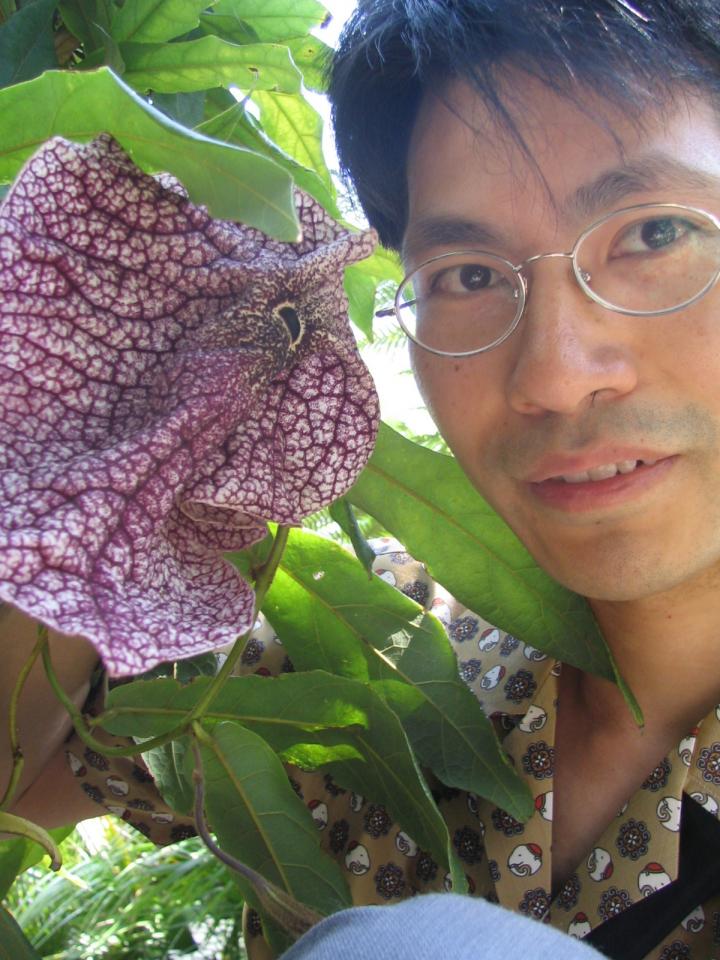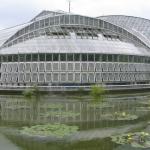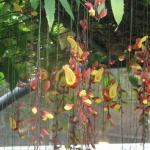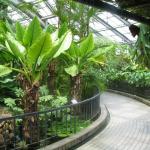Kyoto Botanical Garden
Every year since 1998, I went to S. E. Asia via Japan as my stop-over. Whenever I was in Kyoto, which is only 3 hours of bullet train away from Tokyo, I went to the Kyoto Botanical Garden. It opens 7 days a week and the glasshouse will be the perfect place to walk through on a rainy day or if it is a Monday when all the museums in town are closed.
The Kyoto Botanical Garden was founded in 1917, and opened to the public in 1924. After the World War II, it was occupied by the Allied Forces but was reopened as a botanical garden for relaxation in 1961. In 1992, the Conservatory glasshouse was opened and now the garden can be approached from two entrances. The main gate in the south is near the Kamo river. I usually take the subway to Kitaoji Station, then take the Botanical Garden exit and walk north towards the river. There you can see people fishing at the river, or joggers running with dogs. Walk along the river upstream for about 2 minutes and you will find big round columns as stepping stones across the river to the opposite shore. Cross the river in this way and walk backwards for 5 minutes and the main entrance will be on the left.
Kyoto Botanical Garden is a big place with themes gardens and sometimes special exhibitions not to be missed. The notice board at the main entrance shows all the special highlights and current events.
On the right of the entrance are the European-style garden, and Rose garden, then the sunken garden beyond them. The visitor centre provides a venue for special plant exhibitions, conference and botanical art exposition (in Sept). It also has a nice restaurant on the second floor.
Beyond the sunken garden are the Iris laevigata garden, Peony garden, and Bamboo Collection. The big lawn is in the centre area of the garden with camphor trees, flowering cherry trees, plum trees, coniferous trees on the border and open waters running through the ground planted with Japanese iris, native plants and fragrant shrubs. The perennials and Useful Plants garden has lotus and water-lily in the summer as well as vegetables cultivated on the pergolas.
On the left side of the main avenue is the Conservatory. The image of the glasshouse surrounded by water echoes that of Kinkakuji (Golden Pavillion of Kyoto). The conservatory is classified into different climatic zones. The main area is of tropical climate. It has several body of water to keep humidity to the maximum.
Entering the glass door, one feels the heat immediately but shaded fortunately by the pergola of Thunbergia mysorensis. The beautiful vine has numerous 12 inches pendulous flowers at eye level. Each individual flower opens like a grasping little mouth in yellow with red lips! Other climbing plants are very well presented such as Solanum wendiandii with purple potato flowers, Thunbergia grandiflora with sky blue bird shape flowers, and Tecomanthes venusta with magenta rose colour blooms. The stone pathway curves around several bodies of water with Amazonian water-lily and other water plants. Beaumontia multiform, called the white Easter lily, is growing on the metal hand railing. Cyrtostachys lakka has bright red stem that contracts well against the giant foliage of Typhonodrum lindleyanum. Nypa fruiticosa is a water palm with fine long leaves giving texture to the overall greenness of the conservatory.
Carnivorous plants are grown and the pathway spiral up a small hill planted with colourful and fragrant shrubs. A huge vine is seen hanging from the top of glasshouse. This is Alsomitra macrocarpa. The surrounding banana plants produced colourful blooms to highlight the darker corner shaded by the heavy foliage. I can see Heliconia mariae and H. rostrata. If you visit the Conservatory in spring around April or May, the queen of the vine will certainly catch your attention on the pergola on top of the spiral hill. Strongylodon macrobotrys has jade colour flowers. The inflorescence hangs down like wisteria but reach about 1 metre in length. It is truly spectacular!
The pathway will lead one to the tropical useful plant collection where bananas, fruit trees such as pomelo, cocoa, passion fruit are grown. Then it goes into the tropical highland glasshouse. This area has very high humidity, very bright light but cooler temperature in comparison to the tropical main area. Mountain plants such as Aristolochia, and orchids can be seen. There are several species of Aristolochia namely: A. grandiflora, A. arborea, A. cauliflora, A. peruviana, A. brasiliensis, A. gigantean, A. elegans, and A. tricaudata.
Beyond, one can find the desert plant area, bromeliad area and the orchid area. A special courtyard in an open area within the ground of the conservatory is cultivated with hardy exotics. The native Aristolochia westlandii has beautiful 10 inches flowers and its sister Aristolochia sp. from Kyushu Island has many small, yellow flowers of similar structure that resembles small pipes. At one corner, the golden lotus, Musella lasiocapa is flowering in front of a huge 3 storey high vine. Mucuna sempervirens has dense foliage forming a skeleton where flowers from old stem hangs underneath. The purple flowers are pollinated by bats at night.
I spent my time here painting botanical illustrations and enjoying the exotic flowers. After walking through the Kyoto Botanical Garden, you can exit from the Kitayama Gate at the north side. It is served by the Kitayama Subway Station. However, try to remember not to take the main gate if it is raining heavily for the whole day. Once I found the stepping stones across the Kamo River totally submerged a metre deep under the fast moving water, and have to retreat to the Kitayama Gate again, in pouring rain!
 ThingsAsian
ThingsAsian




















